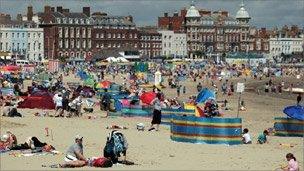Are beach huts the new penthouses?
- Published
Exploring the seaside treasures of Scarborough and Mablethorpe
Beach huts in Scarborough are fetching £35,000, the same price as some one-bedroom flats in the town. So what do you get for your money, and why is the market for beach huts so buoyant?
"It was one of the most exciting moments in my life, having finally got a beach hut."
Margot Charlton's eyes gleamed. She has travelled the world and she loves to ski, but her Mablethorpe hut in Lincolnshire, with its saucy seaside characters painted on the outside, has been a lifelong ambition. And she is not alone.
The housing market may still be struggling, but the beach hut is one property that seems to be holding its own in the downturn.
In Scarborough, more than a hundred new "luxury" beach chalets have just been built. A number are on the market for £35,000, in a town in which you can buy a one-bedroom flat for a little more than £37,000, according to property websites.
Luxury, though, means a small wooden room, four chairs, a table, a plug, a kettle and a single cold water tap. You are not allowed to sleep in it - indeed, you have to leave it by 10.30 each evening. Neither is there hot water nor a toilet. Yet so far this year, 15 have been sold and most are fully let.
Scarborough claims to be the town that gave us the bathing hut. In the 18th Century, it was a mobile hut hauled down the beach to protect nervous bathers while they "took the waters" to improve their health.
The chalets on the North Yorkshire town's south side are now listed. But only a few years ago, many of the chalets were weather beaten and dilapidated. Today, the new brightly-coloured frontages gaze across the bay.
Eileen Prentice and Eileen Pidd are both in their 70s and have for more than 30 years rented a chalet. On the day I visited, there were 16 friends and family squeezed in and around. Next door was Beryl Johnson, another veteran who was seriously considering splashing out on buying one of the new chalets.
Arty huts
Down the coast, Mablethorpe is also having a "beach hut moment". The long seafront now hosts an annual beach hut festival in September. The old rule that the huts must be only one colour plus white has been abandoned.

British seasides have enjoyed a busy summer
Many of the frontages are now highly decorated and there are prizes for the most beautiful. The town has even commissioned avant-garde beach huts.
The cloud hut is designed to observe clouds, the gin and tonic hut is designed to look like a gin and tonic and the canoodling hut is a good place to restore body heat lost after a quick dip in the North Sea.
The private huts, though, are basic. There is not even an indoor tap but the "hutters" are passionate about their community. They can paint whatever they like on the frontages and, for the duration of their stay, enjoy a world without technology or gadgets.
It is a summer of chit-chat, reading and endless beach cricket. And therein lies much of the appeal. Each year the children return a year older, free to roam and wander in and out of one another's little wooden houses. Barbecues are fired up. On chilly days the sweaters and anoraks come out. When the sun shines neighbours exchange sun cream and ointment.
There are around 20,000 beach huts in Britain, and in Dorset, Suffolk and Norfolk prices regularly make headlines.
But the downturn and the current vogue for 1950s "retro" charm seem to have brought a new affection for the humble hut.